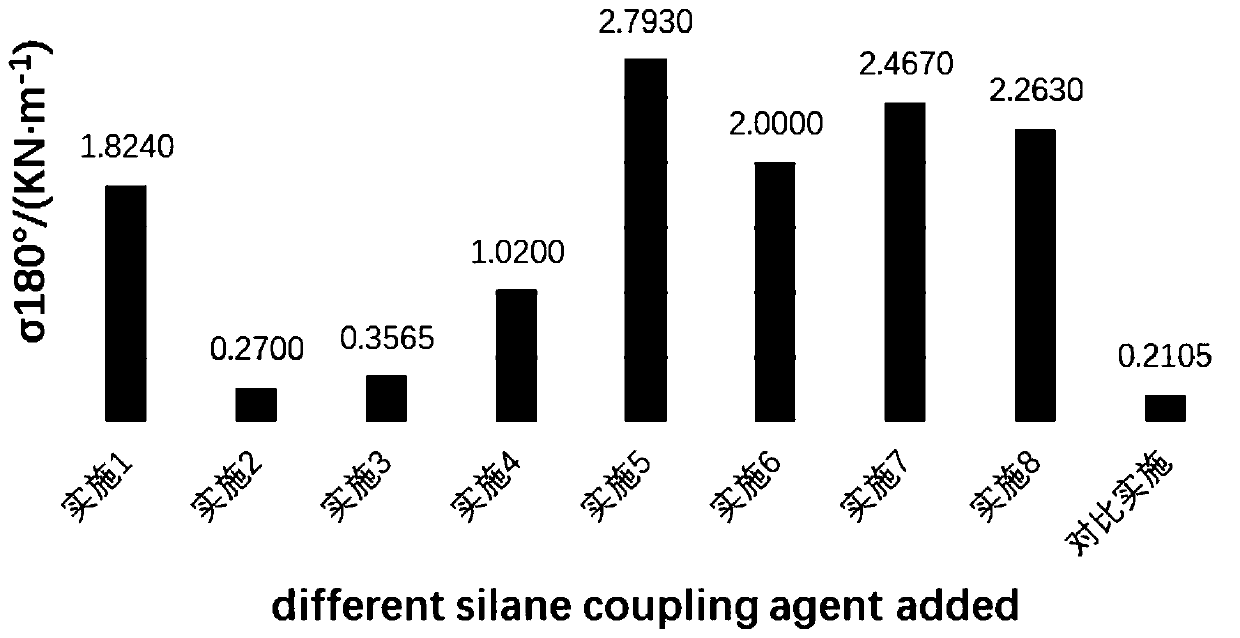Preparation method of enhanced polyvinylidene fluoride lithium battery conductive adhesive
A polyvinylidene fluoride and conductive binder technology, applied in battery electrodes, secondary batteries, circuits, etc., can solve the problems of lithium-ion battery discharge capacity decline, battery system safety hazards, active material shedding, etc. Electrochemical properties, enhanced interfacial stability, and improved bonding properties
- Summary
- Abstract
- Description
- Claims
- Application Information
AI Technical Summary
Problems solved by technology
Method used
Image
Examples
Embodiment 1
[0020] Preparation of enhanced binder: put the silane coupling agent mixture, PVDF, and NMP in a round-bottomed flask at a mass ratio of 1:5:50, and magnetically stir for 1 hour to obtain the enhanced polymer modified by the silane coupling agent. Vinylidene fluoride binder. Among them, the mass ratio of KH550 and KH570 is 0.28:0.72.
[0021] Preparation of positive electrode homogeneous slurry: Mix the positive active material commercial ternary material NCM523, conductive carbon, reinforced polyvinylidene fluoride binder, and NMP according to the mass ratio of 17:2:10:80, and perform ball milling for 1.5h. homogeneously to obtain positive electrode slurry.
[0022] Test sample preparation: Coat the positive electrode slurry on an aluminum foil with a thickness of 15um, dry it, and prepare samples according to the sample preparation requirements in "GB / T2790-1995 Adhesive 180° Peel Strength Test Method Flexible Materials Versus Rigid Materials" test, the result of which is ...
Embodiment 2
[0024] Preparation of reinforced binder: put silane coupling agent mixture:PVDF:NMP in a round bottom flask according to the mass ratio of 2:5:40, and magnetically stir for 3h to obtain the reinforced polymer modified by silane coupling agent. Vinylidene fluoride binder. Among them, the mass ratio of KH560, KH550 and KH570 is 0.4:0.2:0.4.
[0025] Preparation of homogeneous positive electrode slurry: mix the positive active material commercial ternary material NCM523, conductive carbon, reinforced polyvinylidene fluoride binder, and NMP according to the mass ratio of 17:2:10:80, and perform ball milling for 3 hours to mix , to obtain positive electrode slurry.
[0026] Test sample preparation: Coat the positive electrode slurry on an aluminum foil with a thickness of 15um, dry it, and prepare samples according to the sample preparation requirements in "GB / T2790-1995 Adhesive 180° Peel Strength Test Method Flexible Materials Versus Rigid Materials" test, the result of which i...
Embodiment 3
[0028] Preparation of reinforced binder: put the silane coupling agent mixture: PVDF: NMP in a round bottom flask according to the mass ratio of 2:5:50, and magnetically stir for 2 hours to obtain the reinforced polymer modified by silane coupling agent. Vinylidene fluoride binder. The silane coupling agent mixture is made by mixing KH560, KH550, KH570, and KH792 in a mass ratio of 0.35:0.25:0.1:0.3.
[0029] Preparation of homogeneous positive electrode slurry: Mix positive active material commercial ternary material NCM523, conductive carbon, reinforced polyvinylidene fluoride binder, and NMP at a mass ratio of 17:2:10:80, and perform ball milling for 2 hours to mix , to obtain positive electrode slurry.
[0030] Test sample preparation: Coat the positive electrode slurry on an aluminum foil with a thickness of 15um, dry it, and prepare samples according to the sample preparation requirements in "GB / T2790-1995 Adhesive 180° Peel Strength Test Method Flexible Materials Versu...
PUM
 Login to View More
Login to View More Abstract
Description
Claims
Application Information
 Login to View More
Login to View More - Generate Ideas
- Intellectual Property
- Life Sciences
- Materials
- Tech Scout
- Unparalleled Data Quality
- Higher Quality Content
- 60% Fewer Hallucinations
Browse by: Latest US Patents, China's latest patents, Technical Efficacy Thesaurus, Application Domain, Technology Topic, Popular Technical Reports.
© 2025 PatSnap. All rights reserved.Legal|Privacy policy|Modern Slavery Act Transparency Statement|Sitemap|About US| Contact US: help@patsnap.com

